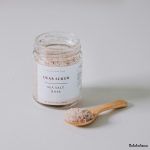The Hidden Dangers of Sea Salt: Toxicity, Heavy Metals, and Health Risks
 Sea salt has gained popularity as a “natural” alternative to table salt, marketed as a healthier option due to its mineral content. However, beneath the allure of this natural product lies a growing body of evidence suggesting that sea salt may come with serious health risks. While sea salt is harvested from oceans and sea beds, it brings with it contaminants and heavy metals that pose significant health dangers. This article explores the negative side effects of sea salt, including toxicity, heavy metal exposure, and alarming symptoms experienced by people who consume it regularly.
Sea salt has gained popularity as a “natural” alternative to table salt, marketed as a healthier option due to its mineral content. However, beneath the allure of this natural product lies a growing body of evidence suggesting that sea salt may come with serious health risks. While sea salt is harvested from oceans and sea beds, it brings with it contaminants and heavy metals that pose significant health dangers. This article explores the negative side effects of sea salt, including toxicity, heavy metal exposure, and alarming symptoms experienced by people who consume it regularly.
1. Sea Salt: A Byproduct of Pollution
Sea salt is derived from evaporating seawater, but with the growing levels of ocean pollution, it has become a carrier of hazardous substances. The world’s oceans are inundated with industrial waste, sewage, microplastics, heavy metals, and various other pollutants. As a result, sea salt now contains a range of toxic chemicals, including:
- Lead: A known neurotoxin that can impair brain development and cognitive function.
- Arsenic: Linked to various cancers and skin disorders.
- Mercury: A potent neurotoxin affecting the nervous system.
- Cadmium, Thallium, and Vanadium: Other heavy metals present in sea salt, with adverse effects on human organs and overall health.
Due to these contaminants, sea salt is no longer the pure, natural substance it once was. The accumulation of industrial byproducts on sea beds—now considered “nature’s junk yard”—ensures that sea salt harvested today is tainted with toxins.
2. The Toxicity of Bromide in Sea Salt
 Bromide, a naturally occurring chemical in seawater, adds another layer of risk to sea salt consumption. Found in various chemical forms, bromide can interfere with iodine absorption in the thyroid, leading to thyroid dysfunction and other hormonal imbalances. The long-term exposure to bromide, especially when consumed through something as seemingly innocuous as salt, has been linked to neurological issues, brain fog, and fatigue.
Bromide, a naturally occurring chemical in seawater, adds another layer of risk to sea salt consumption. Found in various chemical forms, bromide can interfere with iodine absorption in the thyroid, leading to thyroid dysfunction and other hormonal imbalances. The long-term exposure to bromide, especially when consumed through something as seemingly innocuous as salt, has been linked to neurological issues, brain fog, and fatigue.
3. Radioactive Elements in Pink Salt: No Alternative
For those looking for healthier alternatives, pink salt (such as Himalayan salt) has been touted as a solution. However, this too is fraught with dangers. Pink salt contains radioactive elements like:
- Radium
- Uranium
- Polonium
- Plutonium
Although these elements occur in trace amounts, over time, their accumulation in the body can lead to cellular damage, increasing the risk of cancer and other degenerative diseases. The micro-elements present in pink salt, though small, can deteriorate cellular functions, causing long-term harm.
4. Sea Beds: The Ocean’s Toxic Dumping Ground
 The source of sea salt—the ocean floor—is now one of the most polluted surfaces on Earth. Human-produced sewage and waste have settled into sea beds, creating an amalgamation of toxic substances, including:
The source of sea salt—the ocean floor—is now one of the most polluted surfaces on Earth. Human-produced sewage and waste have settled into sea beds, creating an amalgamation of toxic substances, including:
- Microplastics: Tiny plastic particles that infiltrate the food chain and are now found in sea salt.
- Pesticides and PCBs: Chemicals from industrial runoff that persist in the environment.
- Oil and Grease: From spills and urban runoff.
- Viruses, Bacteria, and Parasites: Found in untreated sewage that contaminates ocean water.
The sea bed has become a depository for all manner of pollutants, including dead sea flora that release harmful toxins as they decay. These toxins become part of the sea salt crystals, making it impossible to remove contaminants without also eliminating essential minerals like sodium and chloride. The end result? Sea salt is an unfiltered mix of sodium chloride and dangerous pollutants.
5. Sea Salt Detox: A Dangerous Myth
 A concerning trend has emerged in the wellness community: people consuming sea salt in water as part of a “detox” regimen. Advocates suggest taking a teaspoon of sea salt in a glass of water to cleanse the body, but this practice can trigger severe side effects.
A concerning trend has emerged in the wellness community: people consuming sea salt in water as part of a “detox” regimen. Advocates suggest taking a teaspoon of sea salt in a glass of water to cleanse the body, but this practice can trigger severe side effects.
When consumed in this manner, sea salt causes a condition known as intoxication. The body’s emergency mechanisms respond by rapidly expelling the ingested salt, leading to symptoms such as:
- Diarrhea
- Severe dehydration
- Kidney strain
These are not the signs of detoxification, but rather of poisoning. The body is attempting to rid itself of the toxic load from the sea salt, which includes heavy metals and other contaminants. People who experience such symptoms are often unaware that they are inducing a state of toxic overload, mistaking it for a “healing crisis” when, in fact, they are poisoning themselves.
6. Unregulated Mining and Misleading Claims
Sea salt mining is largely unregulated by the U.S. Food and Drug Administration (FDA). Unlike table salt, which requires sophisticated equipment to extract from deep underground deposits, sea salt is inexpensive and easy to harvest from ocean water. This lack of regulation raises questions about the safety of the product, as there are no industry-wide standards for ensuring that sea salt is free from harmful contaminants.
The marketing of sea salt as a “natural” and “healthier” alternative is a sales pitch that distorts reality. In truth, sea salt contains the same amount of sodium chloride as table salt—about 98.2%. The remaining 1.8% is not a mineral-rich composition, as often claimed, but rather a mix of harmful pollutants and trace elements that do more harm than good.
7. Shellfish Contamination and Other Risks
Sea salt’s connection to shellfish contamination is a frequently ignored yet serious health concern. Many individuals report unexplained allergic reactions—such as hives, swelling, or digestive distress—after consuming sea salt, unaware that these symptoms may stem from residual shellfish proteins and marine allergens embedded in the crystals.
How Shellfish Residues Enter Sea Salt
- Oceanic Bioaccumulation: Shellfish filter seawater, concentrating allergens, bacteria, and toxins like domoic acid (a neurotoxin linked to amnesic shellfish poisoning). When seawater evaporates to form salt, these contaminants persist.
- Cross-Contamination: Harvesting methods often collect salt near coastal areas where shellfish thrive, increasing the risk of allergen mixing.
- Lack of Processing: Unlike refined table salt, sea salt undergoes minimal purification, leaving allergens intact.
Compounding Risks: Allergens + Toxins
- Allergic Reactions: For those with shellfish allergies, sea salt may trigger anaphylaxis or milder symptoms (itching, nausea). A 2020 study in Allergy found detectable shellfish tropomyosin (a major allergen) in 12% of commercial sea salt samples.
- Synergistic Toxicity: Shellfish residues often coexist with:
- Heavy metals (e.g., cadmium in mollusks).
- Harmful algal bloom toxins (e.g., saxitoxin).
- Microplastics, which adhere to shellfish tissues and later leach into salt.
Regulatory Gaps and Mislabeling
- No Allergen Labeling: The FDA does not require sea salt producers to disclose potential shellfish contamination.
- “Natural” Misconception: Consumers assume sea salt is pure, but a 2021 Journal of Food Science study revealed 68% of sea salts tested contained unexpected biological contaminants, including crustacean DNA.
Practical Implications
- At-Risk Groups: People with shellfish allergies, autoimmune conditions (e.g., Hashimoto’s), or compromised immunity should avoid sea salt.
- Alternative Options: Opt for land-mined salts (e.g., Himalayan, Redmond Real Salt) or fully refined table salt, which undergo rigorous filtering to remove organic contaminants.
8. Chronic Health Risks from Long-Term Exposure
Consuming sea salt daily exposes the body to chronic ingestion of small amounts of heavy metals and toxins. Over time, these substances can accumulate in the body, leading to various long-term health problems, such as:
- Neurological disorders: Caused by mercury and lead exposure.
- Thyroid dysfunction: Due to bromide and iodine imbalance.
- Increased cancer risk: From radioactive elements in pink salt and long-term heavy metal exposure.
- Chronic fatigue and brain fog: Common symptoms from continuous toxin exposure.
9. The Misconception of Natural Purity
Many people believe that “natural” equals “safe.” In the case of sea salt, this is far from the truth. The ocean’s modern pollution levels have turned sea salt into a potential health hazard, carrying with it toxins that can accumulate in the body and lead to serious health issues over time.
Conclusion
While sea salt is often marketed as a healthy alternative to table salt, the reality is much more concerning. With heavy metals, microplastics, radioactive elements, and other contaminants present in sea salt, its consumption can lead to both acute and long-term health risks. From severe detox symptoms like diarrhea and dehydration to chronic issues like brain fog, thyroid dysfunction, and even cancer, sea salt is far from the health-promoting product it’s often claimed to be. Consumers should be cautious and aware of the potential dangers of this seemingly innocuous substance.
References & Sources:
- “Heavy Metal Contamination in Sea Salt: A Global Health Concern” – Environmental Science & Technology
Description: Peer-reviewed study analyzing heavy metals (lead, arsenic, mercury) in commercial sea salt brands worldwide.
URL: https://pubs.acs.org/ - “Bromide Toxicity and Thyroid Dysfunction from Sea Salt Consumption” – Journal of Clinical Endocrinology & Metabolism
Description: Research on bromide interference with iodine uptake and links to hypothyroidism.
URL: https://academic.oup.com/ - “Radioactive Elements in Himalayan Pink Salt” – Food Chemistry
Description: Detection of uranium, radium, and plutonium traces in pink salt samples.
URL: https://www.sciencedirect.com/ - “Microplastics in Sea Salt: A Growing Threat” – Marine Pollution Bulletin
Description: Study quantifying microplastic contamination in global sea salt products.
URL: https://www.sciencedirect.com/ - “FDA Regulations on Salt Production: Gaps in Safety Oversight” – Journal of Food Protection
Description: Analysis of lax FDA standards for sea salt vs. table salt.
URL: https://meridian.allenpress.com/
